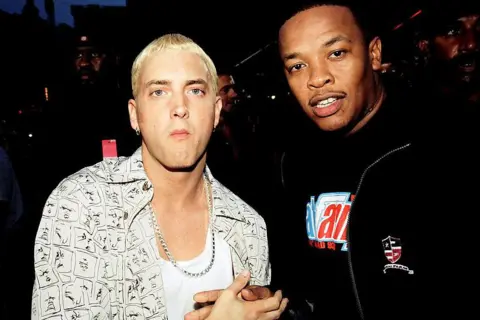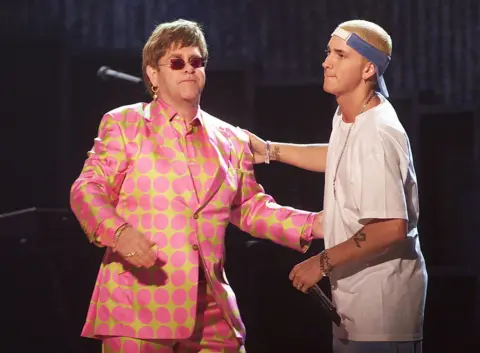Blog
The Demise of Slim Shady: Unraveling the Controversial Legacy Behind Eminem’s Peroxide-Blond Alter Ego
Decades after his explosive emergence, it seems that the enigmatic persona of rapper Eminem’s alter ego, Slim Shady, may finally fade into obscurity. Stemming from Eminem’s self-proclaimed “white trash” upbringing, the provocative Slim Shady, with his peroxide-blond hair and rebellious demeanor, captured the attention of audiences worldwide. In a surprising turn of events, Eminem announced the forthcoming release of his album “The Death of Slim Shady (Coup de Grâce)” this summer, teasing fans with a mock murder news report. The album’s lead single, “Houdini,” featuring appearances from rap icons Dr. Dre, Snoop Dogg, and 50 Cent, as well as comedians Pete Davidson and Shane Gillis, marks Slim Shady’s final chaotic resurgence. As Eminem confronts the rap anti-hero he created, the album’s title hints at a fittingly violent end to Slim Shady, with Eminem himself acknowledging that it was only a matter of time. Reflecting on his journey from Marshall Mathers III, raised in Michigan’s low-income, majority-black neighborhoods, to the global phenomenon of Eminem, the rapper’s legacy is complex and multifaceted. Despite facing initial obstacles in breaking into the music scene, Eminem’s unparalleled rhyming skills and raw talent paved the way for his ascent. With mentorship from the Bass Brothers and a pivotal collaboration with Dr. Dre, Eminem unleashed Slim Shady onto the world stage, challenging societal norms and sparking controversy with his unapologetic lyrics. While his early albums, “The Slim Shady LP” and “The Marshall Mathers LP,” propelled him to superstardom, they also stirred debates over the portrayal of violence, misogyny, and homophobia in his music. Eminem’s ability to navigate the complexities of his alter ego, juxtaposed with his introspective tracks as Marshall Mathers, continues to fascinate and polarize audiences. Despite evolving public opinion and changing trends in hip-hop, Eminem remains a towering figure in the genre, grappling with his legacy while embracing his past. As he prepares to bid farewell to Slim Shady, Eminem embarks on a new chapter, ready to challenge conventions and leave an indelible mark on the world of music once again.

After a quarter-century of cultural turbulence, the enigmatic persona of Slim Shady, the provocative alter ego of rapper Eminem, appears poised for a dramatic farewell. Born from Eminem’s gritty roots and turbulent upbringing, Slim Shady emerged as a symbol of rebellion, clad in peroxide-blond hair and the guise of an everyman in blue jeans. Recently, Eminem announced the impending release of his new album, “The Death of Slim Shady (Coup de Grâce),” in a mock murder news report, hinting at the demise of his iconic alter ego. With the debut single “Houdini,” featuring appearances from rap legends Dr. Dre, Snoop Dogg, and 50 Cent, along with comedians Pete Davidson and Shane Gillis, Eminem confronts the rap anti-hero he birthed. This album title suggests a fittingly violent end to Slim Shady, with Eminem himself acknowledging the inevitability of this conclusion. As Slim Shady prepares for his final bow, it prompts reflection on his complex legacy and enduring impact.
Marshall Mathers III, better known as Eminem, hails from the low-income, predominantly black neighborhoods of Detroit, Michigan. His journey into rap was a means of escape from a tumultuous upbringing marked by strained familial relationships and relentless bullying. Initially facing rejection from major labels, Eminem’s breakthrough came with the birth of Slim Shady, a persona crafted to challenge societal norms and provoke discomfort. Collaborations with rap mogul Dr. Dre and the release of the “Slim Shady LP” propelled Eminem to stardom, confronting America with the disillusioned underbelly hidden beneath its facade of happiness. Despite his commercial success, Eminem’s controversial lyrics, often criticized for their violent misogyny and homophobia, have stirred debate over his artistic intentions and societal impact.

Eminem’s dual personas, Slim Shady and Marshall Mathers, embody conflicting facets of his identity and artistic expression. While Slim Shady revels in shock value and controversy, Marshall Mathers offers introspective narratives that delve into the complexities of fame, mental health, and societal expectations. Songs like “Stan” demonstrate Eminem’s capacity for storytelling and self-awareness, addressing themes of obsession and fan culture with a depth rarely seen in mainstream rap. However, the legacy of Slim Shady is not without its complications, as his portrayal of the angry white male has been appropriated by extremist movements seeking validation for their grievances.

As Eminem navigates the evolving landscape of hip-hop and public opinion, his legacy remains a subject of debate and speculation. While his recent albums have amassed billions of streams, his relevance within contemporary rap discussions has waned in favor of newer voices and genres. With the release of “The Death of Slim Shady,” Eminem confronts his past while embracing the uncertainty of his future. Whether this marks a resurgence or a swan song for Slim Shady, only time will tell. In the words of Eminem himself, “I used to make up my own heroes and my own villains, but my heroes would always die.” The legacy of Slim Shady lives on, evolving with each verse and chorus, leaving an indelible mark on the annals of hip-hop history.
 Skip to content
Skip to content

